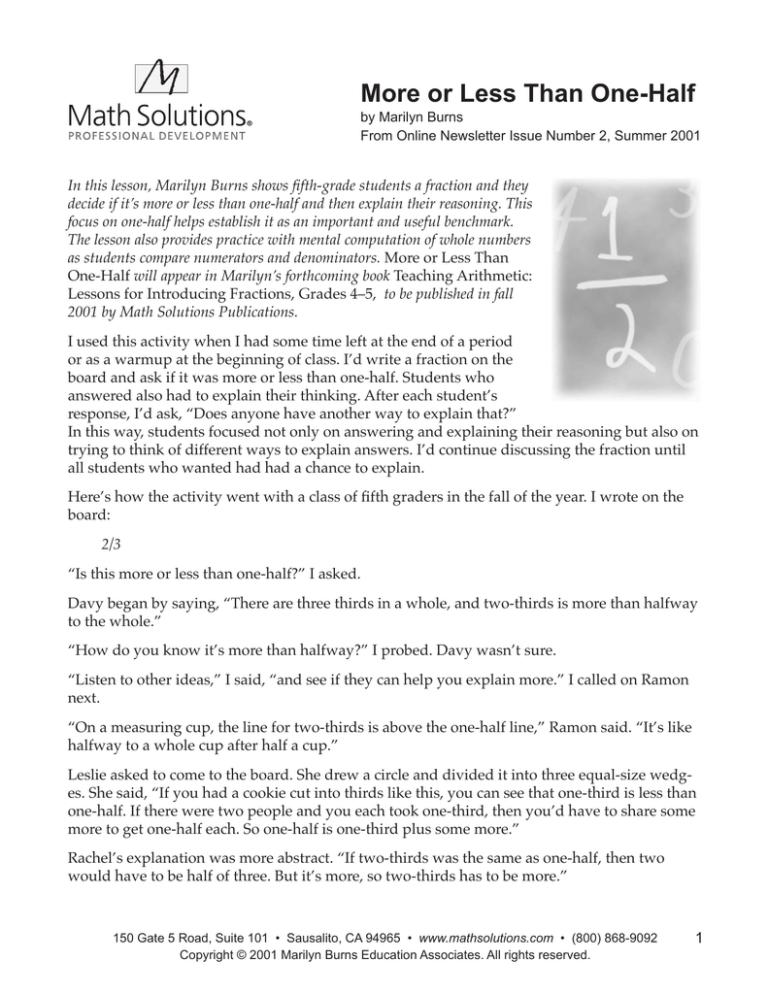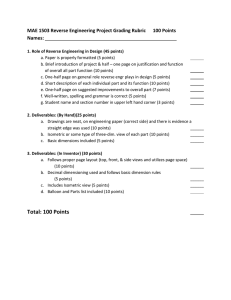
More or Less Than One-Half
by Marilyn Burns
From Online Newsletter Issue Number 2, Summer 2001
In this lesson, Marilyn Burns shows fifth-grade students a fraction and they
decide if it’s more or less than one-half and then explain their reasoning. This
focus on one-half helps establish it as an important and useful benchmark.
The lesson also provides practice with mental computation of whole numbers
as students compare numerators and denominators. More or Less Than
One-Half will appear in Marilyn’s forthcoming book Teaching Arithmetic:
Lessons for Introducing Fractions, Grades 4–5, to be published in fall
2001 by Math Solutions Publications.
I used this activity when I had some time left at the end of a period
or as a warmup at the beginning of class. I’d write a fraction on the
board and ask if it was more or less than one-half. Students who
answered also had to explain their thinking. After each student’s
response, I’d ask, “Does anyone have another way to explain that?”
In this way, students focused not only on answering and explaining their reasoning but also on
trying to think of different ways to explain answers. I’d continue discussing the fraction until
all students who wanted had had a chance to explain.
Here’s how the activity went with a class of fifth graders in the fall of the year. I wrote on the
board:
2/3
“Is this more or less than one-half?” I asked.
Davy began by saying, “There are three thirds in a whole, and two-thirds is more than halfway
to the whole.”
“How do you know it’s more than halfway?” I probed. Davy wasn’t sure.
“Listen to other ideas,” I said, “and see if they can help you explain more.” I called on Ramon
next.
“On a measuring cup, the line for two-thirds is above the one-half line,” Ramon said. “It’s like
halfway to a whole cup after half a cup.”
Leslie asked to come to the board. She drew a circle and divided it into three equal-size wedges. She said, “If you had a cookie cut into thirds like this, you can see that one-third is less than
one-half. If there were two people and you each took one-third, then you’d have to share some
more to get one-half each. So one-half is one-third plus some more.”
Rachel’s explanation was more abstract. “If two-thirds was the same as one-half, then two
would have to be half of three. But it’s more, so two-thirds has to be more.”
150 Gate 5 Road, Suite 101 • Sausalito, CA 94965 • www.mathsolutions.com • (800) 868-9092
Copyright © 2001 Marilyn Burns Education Associates. All rights reserved.
1
More or Less Than One-Half, continued
One day, I chose one and one-quarter for the fraction. When I wrote it on the board, some
students laughed and others blurted out comments: “Simple!” “That’s easy.” “No-brainer.”
Practically every student raised a hand.
“More or less?” I asked. “Let’s all say the answer softly together.” That took care of the answer.
“Who can explain why one and a fourth is more than one-half?” I then asked. Again, there
were lots of volunteers.
“It’s obvious,” Daniel said, “because one-half is less than one and one and one fourth is more
than one, so it has to be more than one-half.”
“It’s more than twice as big,” Sadie said, “because one-half and one-half are one and one and a
fourth is even more than that.”
“On the number line, they’re on different sides of one,” Emma said. “That shows one-half is
less.”
Even for an obvious solution, students may think in different ways. Listening to their thinking
often gives me new insights into students’ understanding. Also, sometimes students think in
ways I hadn’t thought of, giving me new ways to look at the mathematics.
For this activity, I sometimes selected fractions with larger numerators and denominators, at
times choosing fractions that were easy to analyze, such as 61/100 or 400/1000, but at other
times choosing fractions that also offered a mental computation challenge, such as 127/260,
89/180, even 267/498. The students seemed to like stretching their thinking to decide if fractions like these were more or less than one-half.
150 Gate 5 Road, Suite 101 • Sausalito, CA 94965 • www.mathsolutions.com • (800) 868-9092
Copyright © 2001 Marilyn Burns Education Associates. All rights reserved.
2



